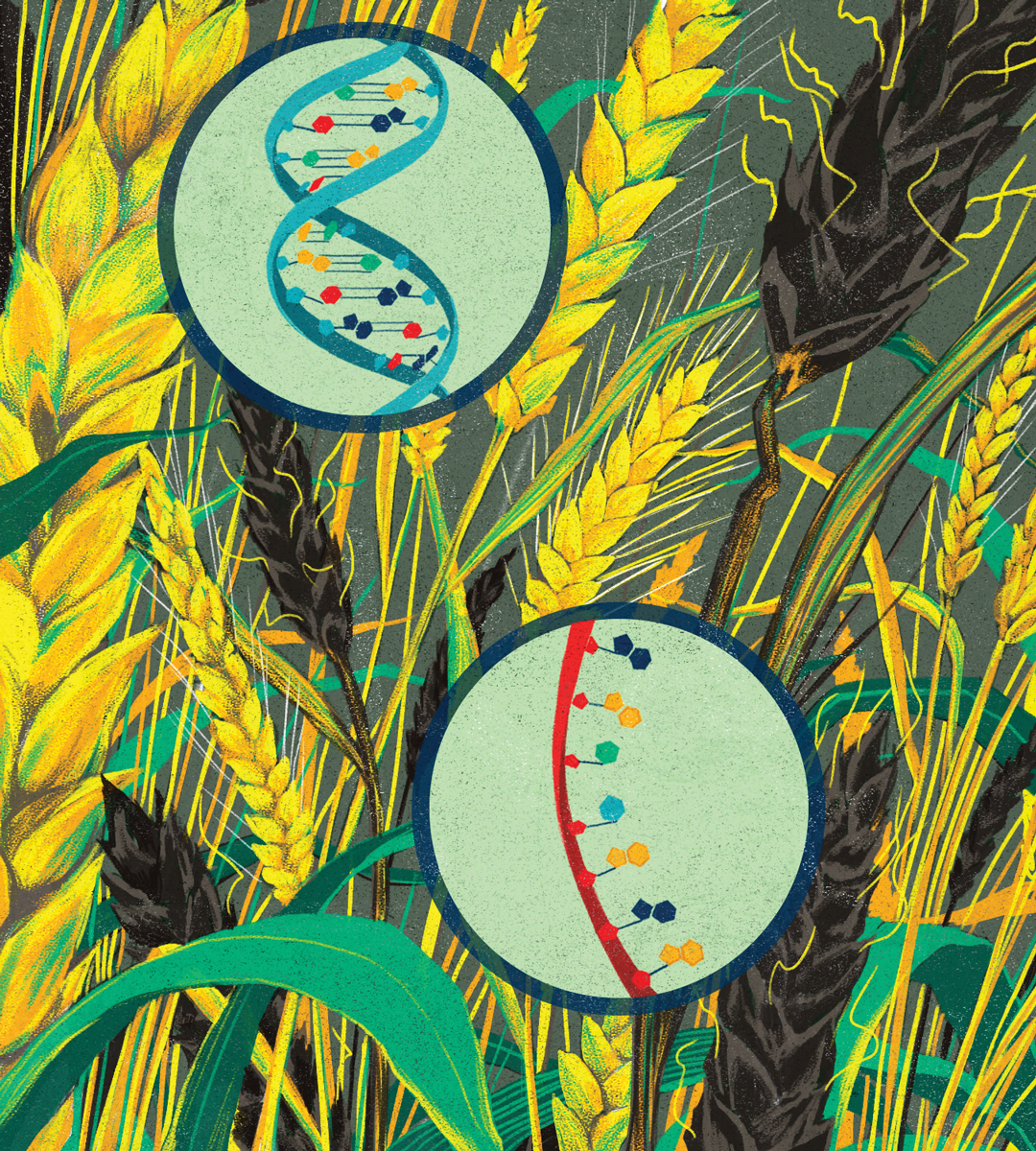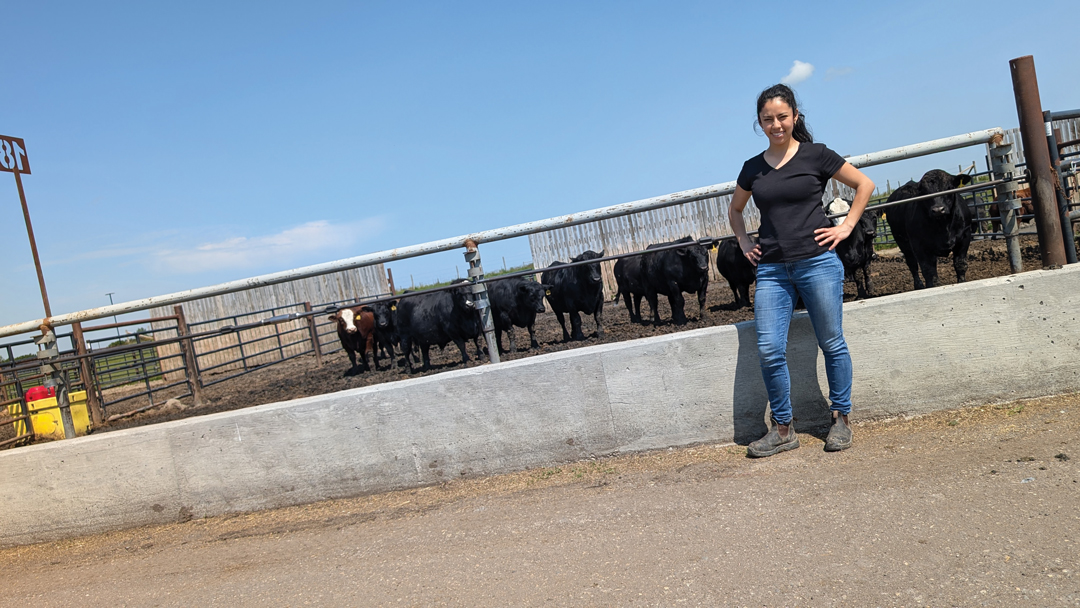IN SEARCH OF OPTIONS
BY IAN DOIG • ILLUSTRATION BY JASON LIN
Research proposals involving ribonucleic acid interference (RNAi) began to cross Lauren Comin’s desk three years ago. Since then, the gene-inhibiting technology has developed a revolutionary aura as a potential next big thing in crop protection.
Despite its potential use in non-toxic weed and insect sprays, seed treatments, as a regulator of plant development and even in plant breeding, the advancement of farming applications has been slow.
This is changing as government action, activist pressure and consumer agitation on crop-protection chemistry create regulatory uncertainty around the globe, spurring a desire among farmers for options. “Farmers see it has potential,” said Comin, Alberta Wheat Commission director of research. “That’s why we’re funding it now. It’s another alternative and having as many options as we can is our goal.
“We don’t know five years from now what will happen. If a chemistry gets taken away, then you have to go to a chemistry that might be even more problematic. Or, it’s more expensive or you can’t use anything at all and we have an absolute disaster on our hands.”
HOW IT WORKS
RNA resembles DNA, the genetic material known collectively as the genome, that is the basic instruction manual that defines the physical form and bodily processes of living things. When we eat any food, a large part of it is RNA. Messenger RNA is used by plant and animal cells to communicate genetic information encoded within DNA.
Cells naturally interfere with RNA as a means of protection and self-regulation. They use natural RNAi pathways to fight off viruses and to control and manage their genome. Employing enzymes called Dicer, they search the cell for the double strands of the RNA, chopping it up (hence the name) and searching for similar bits to degrade.
RNAi can also be used by scientists as a means of blocking the function of this messenger RNA, effectively turning off the process controlled by a targeted gene. RNAi has wide potential for application in medicine and biotechnology as well as in agriculture, where its use has been demonstrated to produce practical results. It has been used to create decaffeinated coffee beans and non-allergenic peanuts among other breeding innovations and can potentially kill insects by affecting genes such as those that control their digestive processes. It can also be used to attack weeds and crop disease pathogens.
Central to the appeal of the technology, RNAi crop applications are non-toxic. Like keys that can only unlock a single door, they can affect only the target organism they’ve been created to control. Applications likely have no effect on other species such as humans and fish and, being composed of organic matter, are biodegradable. With questions around human health and the environment satisfied, hopes for proving the technology’s effectiveness in crop protection are high. As well, RNAi technology does not involve a transgenic element, and so it would not be subject to GMO regulations.
SMITING SMUTS AND BUNTS
As a tool to control weeds and crop pests, RNAi is selective, targeting only the genes responsible for individual traits in the target fungus, weed or insect. While broad-spectrum chemicals may impact unintended targets, the specificity of RNAi minimizes the possibility. It can’t be completely ruled out that an RNAi fungal treatment may affect the soil microbiome but fungi and humans have very different genetic pathways, making such interaction impossible.
Agriculture and Agri-Food Canada (AAFC) research scientist John Laurie works at the Lethbridge Research and Development Centre, where he’s leading a three-year RNAi seed-treatment project funded in part by the Alberta Wheat Commission (AWC). When GrainsWest spoke with Laurie in June, he acknowledged RNAi technology has generated a great deal of interest, but cautioned that this project is just starting. Nonetheless, even before work had begun, his lab had been contacted by multiple companies interested in the eventual commercialization of the results.
The project aims to develop a seed coating that will suppress smuts and bunts using nanocarrier-complexed RNAi. The process utilizes cell-penetrating peptides, which are short chains of amino acids able to pass through cell membranes. These are used to piggyback RNA into the cells of the target organism.
During germination, plants are vulnerable to infection by pathogens. From this treatment, the seed will receive disease protection as well as having its own genes modulated to promote development at the seedling stage.
Laurie likens the process to a person wearing gloves to avoid picking up cold germs from a door handle. “We’re putting a biodegradable, non-toxic glove on the seed. It would essentially be to make the seed resistant or to block the infection.”
If germination is like passing through a doorway, when the seed wears its RNAi gloves, it enters the next stage of its life without becoming infected by the microorganisms lurking on the metaphoric door handle.
This is a time of great interest in the soil microbiome that sees scientists studying the activities of microorganisms that assist plant growth. Toxic, broad-spectrum fungicides have proven a double-edged sword in this underground realm in that they eliminate both beneficial bacteria and fungi as well as their undesirable cousins. Laurie noted that where farmers have switched to organic practices, the smuts and bunts that plagued agriculture prior to the 1900s, have reappeared.
“We want to facilitate the next generation of microbiome related seed technologies,” he said. “To do that, we probably have to get away from these fungicides, which means smuts and bunts will immediately become a problem.”
Using the specificity of RNAi to shut down the infection process of the smut or bunt, the treatment Laurie intends to develop is expected to have zero impact on beneficial soil organisms. Additionally, the plant’s gene expression can be tweaked to strengthen its relationship with these beneficials.
FIGHTING FHB
Like Laurie, AAFC Saskatoon Research and Development Centre research scientist Steve Robinson said the development of RNAi technology may represent a widespread change in agronomic practice. He is heading an ongoing project developing RNAi sprays to combat sclerotinia in canola but primarily Fusarium head blight (FHB) in wheat. Robinson described the initiative as complementing breeding projects whose aim is to create resistant crop varieties. “This is a parallel strategy to develop ways to mitigate persistent and potentially devastating diseases,” he said.
The project is now working in the lab to identify candidate FHB genes that can be targeted using RNAi to produce a formulation that can control the disease in the field. Robinson’s team is mining the genomes of the pathogens that cause sclerotinia and FHB for potential target genes. Measuring changes in gene expression during the infection process in both the wheat and the FHB pathogen, they have identified promising genes. In a two-pronged attack, they intend to kill the bulk of the FHB infection while silencing genes involved in DON production, halting or limiting the production of the mycotoxin.
Again, the advantage over non-specific broad-spectrum fungicide is the RNAi spray’s ability to target only FHB pathogens and not beneficial soil microorganisms while completely biodegrading within weeks. The study is now focusing on Fusarium graminarium but Robinson said by tweaking the design of the spray, it could tackle a multitude of FHB-related pathogens.
Just over a year into this three-year project that will likely be followed up with another three-year phase, Robinson said initial results are promising. He explained, however, that any resulting FHB treatment won’t be available to farmers for years. Once the final product is demonstrated to be non-toxic, it must be tested in field trials. This will require scaling up production of RNA that is now produced through fermention by bacteria that produce RNA molecules. Importantly, this is a formerly expensive process that can now be done for considerably less.
Convinced RNAi truly is the next big thing, Robinson
emphasized the technology has to prove viable. “It’s got to be as effective as the sprays available to producers now to stand any chance.”
If positive lab results can be duplicated in the field, AAFC would search for an industry partner to negotiate regulatory hurdles and commercialization. Robinson added that crop input companies are taking the potential of RNAi technology seriously. Given there is no great philosophical problem in getting these non-transgenic products to market, once it can be demonstrated there is profit in producing them, they should take off.







Comments